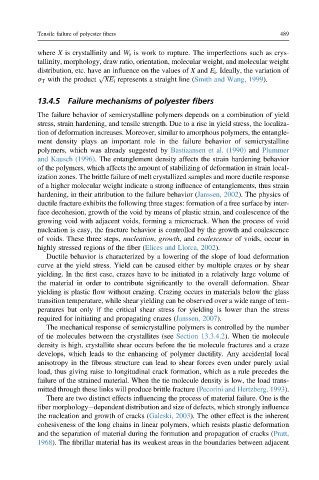Page 516 - Handbook of Properties of Textile and Technical Fibres
P. 516
Tensile failure of polyester fibers 489
where X is crystallinity and W r is work to rupture. The imperfections such as crys-
tallinity, morphology, draw ratio, orientation, molecular weight, and molecular weight
distribution, etc. have an influence on the values of X and E i . Ideally, the variation of
p ffiffiffiffiffiffiffiffi
s T with the product XE i represents a straight line (Smith and Wang, 1999).
13.4.5 Failure mechanisms of polyester fibers
The failure behavior of semicrystalline polymers depends on a combination of yield
stress, strain hardening, and tensile strength. Due to a rise in yield stress, the localiza-
tion of deformation increases. Moreover, similar to amorphous polymers, the entangle-
ment density plays an important role in the failure behavior of semicrystalline
polymers, which was already suggested by Bastiaansen et al. (1990) and Plummer
and Kausch (1996). The entanglement density affects the strain hardening behavior
of the polymers, which affects the amount of stabilizing of deformation in strain local-
ization zones. The brittle failure of melt crystallized samples and more ductile response
of a higher molecular weight indicate a strong influence of entanglements, thus strain
hardening, in their attribution to the failure behavior (Janssen, 2002). The physics of
ductile fracture exhibits the following three stages: formation of a free surface by inter-
face decohesion, growth of the void by means of plastic strain, and coalescence of the
growing void with adjacent voids, forming a microcrack. When the process of void
nucleation is easy, the fracture behavior is controlled by the growth and coalescence
of voids. These three steps, nucleation, growth, and coalescence of voids, occur in
highly stressed regions of the fiber (Elices and Llorca, 2002).
Ductile behavior is characterized by a lowering of the slope of load deformation
curve at the yield stress. Yield can be caused either by multiple crazes or by shear
yielding. In the first case, crazes have to be initiated in a relatively large volume of
the material in order to contribute significantly to the overall deformation. Shear
yielding is plastic flow without crazing. Crazing occurs in materials below the glass
transition temperature, while shear yielding can be observed over a wide range of tem-
peratures but only if the critical shear stress for yielding is lower than the stress
required for initiating and propagating crazes (Janssen, 2007).
The mechanical response of semicrystalline polymers is controlled by the number
of tie molecules between the crystallites (see Section 13.3.4.2). When tie molecule
density is high, crystallite shear occurs before the tie molecule fractures and a craze
develops, which leads to the enhancing of polymer ductility. Any accidental local
anisotropy in the fibrous structure can lead to shear forces even under purely axial
load, thus giving raise to longitudinal crack formation, which as a rule precedes the
failure of the strained material. When the tie molecule density is low, the load trans-
mitted through these links will produce brittle fracture (Pecorini and Hertzberg, 1993).
There are two distinct effects influencing the process of material failure. One is the
fiber morphologyedependent distribution and size of defects, which strongly influence
the nucleation and growth of cracks (Galeski, 2003). The other effect is the inherent
cohesiveness of the long chains in linear polymers, which resists plastic deformation
and the separation of material during the formation and propagation of cracks (Pratt,
1968). The fibrillar material has its weakest areas in the boundaries between adjacent

